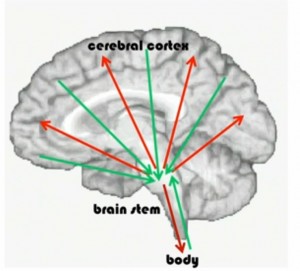Here is a wonderful and concise description of consciousness and the self. I am listening/reading by Antonio Damasio‘s book “Self Comes to Mind” and then found this video. I’d recommend the book. The video is a good preview.
The following text comes from the TED transcript of his talk. Thanks to TED for the multi-modal presentation. It helps me learn and I think you will find it helpful as well. Look for the transcript button just below the video screen for more.
Damasio:
You could rightly ask, why care about this?… First, curiosity. Primates are extremely curious — and humans most of all… why should we not be interested in what is going on inside of human beings?
Second, understanding society and culture. We should look at how society and culture in this socio-cultural regulation are a work in progress. And finally, medicine. Let’s not forget that some of the worst diseases of humankind are diseases such as depression, Alzheimer’s disease, drug addiction. Think of strokes that can devastate your mind or render you unconscious. You have no prayer of treating those diseases effectively and in a non-serendipitous way if you do not know how this works. So that’s a very good reason beyond curiosity to justify what we’re doing, and to justify having some interest in what is going on in our brains.
Damasio:
And we could take a very simple view and say, well, it [consciousness] is that which we lose when we fall into deep sleep without dreams, or when we go under anesthesia, and it is what we regain when we recover from sleep or from anesthesia. But what is exactly that stuff that we lose under anesthesia, or when we are in deep, dreamless sleep? Well first of all, it is a mind, which is a flow of mental images.
But what about the self? The self is really the elusive problem. And for a long time, people did not even want to touch it, because they’d say, “How can you have this reference point, this stability, that is required to maintain the continuity of selves day after day?”
So let me tell you just a little bit about how I came to this. I came to this because, if you’re going to have a reference that we know as self — the Me, the I in our own processing — we need to have something that is stable, something that does not deviate much from day to day. Well it so happens that we have a singular body. We have one body, not two, not three. And so that is a beginning. There is just one reference point, which is the body.

So what is the picture that we get here? Look at “cerebral cortex,” look at “brain stem,” look at “body,” and you get the picture of the inter connectivity in which you have the brain stem providing the grounding for the self in a very tight interconnection with the body. And you have the cerebral cortex providing the great spectacle of our minds with the profusion of images that are, in fact, the contents of our minds and that we normally pay most attention to, as we should, because that’s really the film that is rolling in our minds. But look at the arrows. They’re not there for looks. They’re there because there’s this very close interaction. You cannot have a conscious mind if you don’t have the interaction between cerebral cortex and brain stem. You cannot have a conscious mind if you don’t have the interaction between the brain stem and the body.




